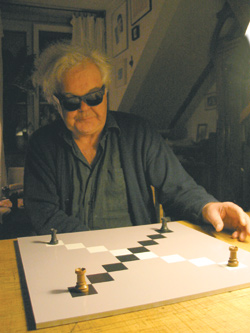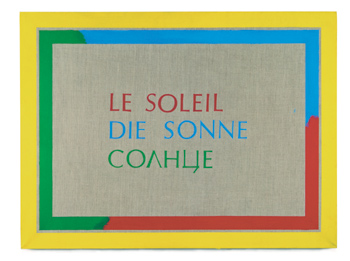Professor extraordinarius
Ten years ago, the world of Andrzej Dłużniewski, an acclaimed avant-garde artist, faded to black. It wasn't his fault. The car he was driving was hit by a lorry. In the accident he lost his eyesight.

Andrzej Dłużniewski can't be labeled as a painter, sculptor, performer or writer. He does it all. In his art, the essence comes before the form. He always speaks of art as a mental thing. His works tend to be crude, void of dazzling displays of skill. Instead, they are a display of thought, a kind of riddles. Like, for example, a gray canvas on which he wrote, with a slightly darker shade of grey, the words: so hard to count butterflies.

A mark left by a painting
Andrzej Dłużniewski studied architecture and philosophy but ultimately he graduated from the Warsaw Academy of Fine Arts where he studied sculpture. In 1970 he was elected to a fellowship there and set up a Workshop of Intermedias. What exactly are intermedias?
- Intermedia is a space between – explains the professor – It fills the spaces left by the conventional disciplines. It tries to capture what you cannot render in painting, photography or sculpture. It explores these spaces between, which are full of meaning and emotion and can't be ignored. It is a disciple shaped by the artist as there are no established conventions and formulas there.
The work he prepared for his master thesis was also of an intermedia kind – a series of photographs showing a big „sandbox” filled with dry sand out of which he had fashioned various landscapes. The work raised much controversy among the faculty but after a long debate they decided that such approach to sculpture was acceptable. Then it got even more unconventional with „A copy of a painting of a copy of a painting of a copy of a reproduction of a painting of a reproduction of a painting” or „A mark left by a painting” (a photograph of a mark left by a painting removed from the wall).

He also explored the relations between the meaning of words and
their grammatical gender in various languages and rendered the
results of his studies on canvas, using three coulours.
- The most prominent characteristic of Dłużniewski's art is its
conceptual origin, its intellectual foundation, which were
important in the early 70's, when a new tendency in art, called
conceptual art, was flourishing – states Wojciech Krukowski, the
director of the Centre for Contemporary Art in Warsaw and
Dłużniewski's friend – For conceptualists the most important was
the idea and the intellectual motivation behind a work of art.
There's no room for a psychological or an expressive reaction.
Intermedia, conceptual art and many other things were discussed in Dłużniewscy's flat on Piwna Street which was an important centre of the artistic community in the 80's and the 90's.
Words
„1998 was for me a year of transition. All of a sudden many of
the things I considered wise seemed stupid and the other way round
– I found traces of wisdom in things most absurd” - these are the
opening lines of „Odlot”, a collection of humorous stories
published by Dłużniewski in 2000. He had written them two years
earlier after having lost his desperate struggle to retain his
eyesight.
- It was during the first year of my disability – he recalls – I
then decided, perhaps instinctively, to start writing, as it seemed
no longer possible to pursue the visual arts, which were always my
speciality. I had to look back, to re-evaluate things. Most of my
life I wasn't blind, I experienced the world through images. For
most people it would be a tragedy but I didn't want it to be so in
my case.
The characters of „Odlot” are: Dłużniewski himself, Mr Zbynio
the stoic and the least likeable of the three, the professor. The
three personas are different facets of Dłużniewski's personality
and they are constantly engaged in never-ending disputes.
Writing proved an excellent therapy. True to form, professor
Dłużniewski presents his own, ironic and humorous account of
it:
- I used to write on separate sheets of paper, using my knee for a
desk. I sometimes wrote one thing on top of the other and my wife
had hard time deciphering it. Once I wrote several pages without
realising that my pen had run out. But I was pressing so hard that
I literally engraved the words on the paper so we smeared it with
graphite and managed to read the text.
Geonauts
„They have arrived recently and won't stay long. The purpose of
their visit is quite simple. They didn't come here to conquer, to
exploit or to learn. They simply wish to see whether their presence
and their lifestyle bother the natives. Since they've found that is
the case they are preparing to leave and won't stay long” - that's
how Prof. Dłużniewski describes Geonauts in his book. Geonauts are
hundreds of small bronze figures, sitting on large white
pedestals.
- After the accident my fellow colleagues the sculptors, eager to
help me, brought me some wax. I'd never worked with wax before – he
relates – I started making these little figures. After I'd made a
whole bunch of them they were cast in bronze. Everyone said they
looked quite smart.

His collegues from the Academy of Fine Arts probably didn't even
realise how much help they were.
Although initially it was just a form of therapy, it stirred up a
new creative potential in him – says Wojciech Krukowski – His
intellectual faculty of an artist accommodated very easily and
embraced this new form of creation.
The Academy also reacted very sympathetically and made no
objections when Prof. Dłużniewski decided to go back to
lecturing.
- I didn't think I would be able to work at the Academy again – he
admits – It was possible because we always used to spend most of
the time speaking to students, so I still speak with them. The
visual aspect of their work is supervised by my assistant. The
results vary, but it's all right, as long as it makes any sense,
because sense is something we can talk about.
1 Consistent Street
„Geonauts”, „Odlot” and lecturing at the Academy proved an
excellent therapy. Dłużniewski is an active and exhibiting artist
once again. Whenever he wants something painted, he can always
count on his wife, Emilia Małgorzata, who is a painter and on a
young artist named Maciej Sawicki.
- I just sit on a couch and tell everyone what to do – he says with
a laugh. He's still unconventional, inconsistent and in good form –
Consistency frightens me – he explains – I've once come to a
conclusion that if there was Consistency Street in my mind's
landscape, it would be a very short one, one block long
probably.

Being consistently inconsistent, he has recently disassembled an
old chessboard to create some absurd compositions. He is also
writing stories about a cat and a rabbit. He sometimes even forgets
he's blind.
- I can't say I'm happy with the situation, although I pretend to
be – he says and adds – That's just the way it is. It's different.
Only now it's hard to count butterflies...
Artykuł powstał w ramach projektu "Integracja
- Praca. Wydawnicza kampania informacyjno-promocyjna"
współfinansowanego z Europejskiego Funduszu Społecznego w ramach
Sektorowego Programu Operacyjnego Rozwój Zasobów Ludzkich.
Komentarze
brak komentarzy




![kadr z filmu My skrajnie otyli [FILM]](/files/nowe.niepelnosprawni.pl/public/2024/thumbnail_gajda_youtube_nowe.jpg)
Dodaj komentarz